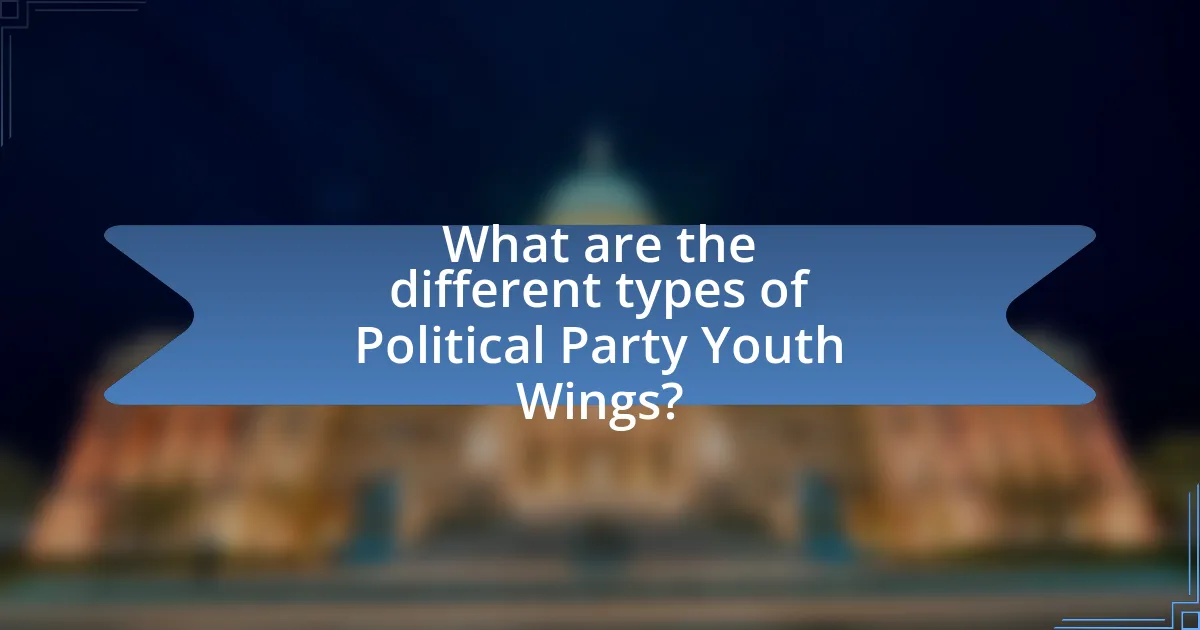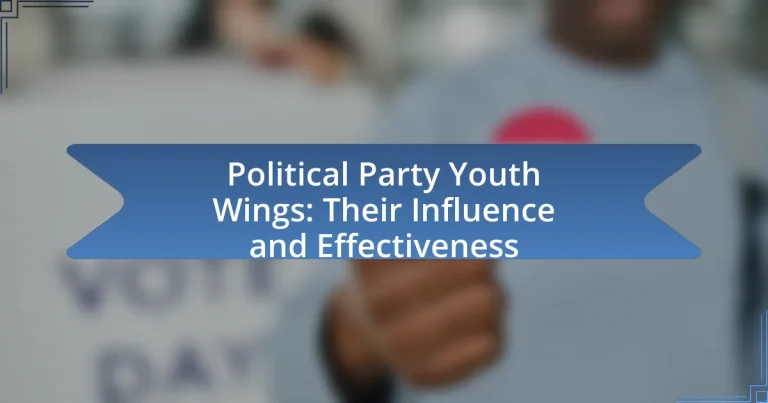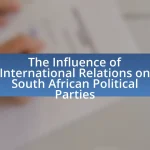Political Party Youth Wings are organized groups within political parties aimed at engaging and mobilizing young people in political activities. They serve as platforms for youth to express their views, influence party policies, and promote agendas that resonate with younger demographics. The article explores the functions of youth wings, their roles in political campaigns, and their impact on voter engagement and party decision-making. It also examines the challenges these wings face, their effectiveness in influencing politics, and strategies for enhancing their influence through grassroots mobilization and social media engagement. Additionally, the article categorizes different types of youth wings and discusses best practices for maximizing their effectiveness in modern political contexts.

What are Political Party Youth Wings?
Political Party Youth Wings are organized groups within political parties that focus on engaging and mobilizing young people in political activities. These wings serve as a platform for youth to express their views, participate in party decision-making, and promote the party’s agenda among younger demographics. Historically, youth wings have played significant roles in elections, often influencing voter turnout and shaping party policies to appeal to younger voters. For example, in the United States, the Young Democrats and Young Republicans have been instrumental in fostering political engagement among youth, demonstrating their effectiveness in mobilizing support during elections.
How do Political Party Youth Wings function within their parties?
Political Party Youth Wings function as the primary platform for engaging young members in political activities and decision-making processes within their parties. These wings typically organize events, campaigns, and outreach initiatives aimed at mobilizing youth support and fostering political awareness among younger demographics. For instance, youth wings often participate in grassroots organizing, policy advocacy, and electoral campaigns, which can significantly influence party strategies and voter engagement. Research indicates that youth wings can enhance party effectiveness by bringing fresh perspectives and addressing issues pertinent to younger voters, thereby contributing to the overall dynamism and adaptability of political parties.
What roles do youth wings play in political campaigns?
Youth wings play a crucial role in political campaigns by mobilizing young voters, shaping party policies, and enhancing grassroots engagement. These organizations often serve as a bridge between the party and the youth demographic, facilitating communication and promoting political participation among younger constituents. For instance, during the 2020 U.S. presidential election, youth wings significantly contributed to voter turnout, with 50% of eligible voters aged 18-29 participating, compared to 36% in 2016, demonstrating their effectiveness in galvanizing support. Additionally, youth wings often advocate for issues that resonate with younger voters, such as climate change and social justice, influencing the broader party agenda and attracting a more diverse electorate.
How do youth wings influence party policies and decisions?
Youth wings influence party policies and decisions by serving as a platform for young members to express their views and advocate for issues relevant to their demographic. These organizations often mobilize grassroots support, engage in political campaigning, and provide feedback to party leadership, thereby shaping the party’s agenda. For instance, youth wings have been instrumental in pushing for progressive policies on climate change and social justice, reflecting the priorities of younger voters. Their ability to organize events, utilize social media, and connect with peers enhances their impact, as seen in various electoral campaigns where youth engagement has led to increased voter turnout and policy shifts.
Why are Political Party Youth Wings important in modern politics?
Political Party Youth Wings are important in modern politics because they serve as a vital link between political parties and the younger electorate, fostering political engagement and activism among youth. These wings mobilize young voters, who represent a significant demographic, as evidenced by the fact that in many countries, youth turnout can sway election outcomes. For instance, in the 2020 U.S. presidential election, voters aged 18-29 accounted for 50% of eligible voters in that age group, highlighting their potential impact. Additionally, youth wings often advocate for issues that resonate with younger generations, such as climate change and social justice, thereby influencing party platforms and policies. This engagement not only energizes the political landscape but also ensures that the perspectives and needs of younger citizens are represented in the political discourse.
What impact do youth wings have on voter engagement?
Youth wings significantly enhance voter engagement by mobilizing young voters and fostering political participation. These organizations often utilize social media and grassroots campaigns to reach and resonate with younger demographics, effectively increasing turnout rates. For instance, research from the Pew Research Center indicates that youth wings can lead to a 10-15% increase in voter turnout among young people when actively campaigning. Additionally, youth wings provide platforms for political education and discussion, which further encourages informed voting.
How do youth wings contribute to the political education of young people?
Youth wings contribute to the political education of young people by providing structured platforms for engagement, discussion, and activism. These organizations facilitate workshops, seminars, and training sessions that cover political theory, civic responsibilities, and current events, thereby enhancing political literacy among youth. For instance, a study by the National Democratic Institute found that youth wings significantly increase political participation and awareness, with 70% of participants reporting improved understanding of political processes after involvement in youth wing activities. This structured approach not only informs young people about political systems but also encourages critical thinking and active participation in democratic processes.

What are the different types of Political Party Youth Wings?
Political party youth wings can be categorized into several types based on their organizational structure and political orientation. The primary types include:
-
Affiliated Youth Organizations: These are directly linked to a political party and operate under its umbrella, often sharing the party’s ideology and goals. Examples include the Young Democrats of America and the Young Republicans.
-
Independent Youth Movements: These groups may align with a political party but operate independently, advocating for specific issues or reforms. They often seek to influence party policies from the outside.
-
Student Political Organizations: These are typically found on college campuses and focus on engaging students in political discourse and activism, often representing various political ideologies.
-
Youth Advocacy Groups: These organizations focus on specific issues such as climate change, education reform, or social justice, and may collaborate with political parties to promote their agendas.
-
International Youth Wings: Some political parties have youth wings that operate on an international level, connecting with similar organizations across different countries to promote shared values and objectives.
These categories reflect the diverse ways in which youth engage in politics and influence party dynamics.
How do various youth wings differ across political parties?
Youth wings across political parties differ primarily in their ideological alignment, organizational structure, and engagement strategies. For instance, the youth wing of a left-leaning party may focus on social justice and environmental issues, while a right-leaning party’s youth wing might prioritize economic growth and traditional values. The organizational structure can vary significantly; some youth wings operate independently, while others are tightly integrated with the parent party, influencing their decision-making processes. Engagement strategies also differ, with some youth wings utilizing social media campaigns to mobilize support, while others may focus on grassroots activism and community outreach. These differences reflect the broader goals and values of their respective political parties, shaping their effectiveness in mobilizing young voters.
What are the common structures of youth wings in different political contexts?
Youth wings in different political contexts commonly exhibit structures that include a leadership hierarchy, membership tiers, and functional committees. Leadership typically consists of elected officials such as a president, vice president, and secretary, who guide the organization and represent its interests. Membership tiers often categorize individuals based on age or engagement level, allowing for inclusivity while maintaining a focus on youth issues. Functional committees, such as those for outreach, policy development, and event planning, facilitate specific tasks and enhance organizational effectiveness. These structures are designed to empower young members, promote political engagement, and ensure representation within the broader political party framework.
How do ideological differences shape the activities of youth wings?
Ideological differences significantly shape the activities of youth wings by influencing their policy priorities, campaign strategies, and engagement methods. For instance, youth wings aligned with progressive ideologies often focus on social justice issues, climate change, and inclusivity, leading them to organize rallies, awareness campaigns, and community service projects that reflect these values. Conversely, youth wings with conservative ideologies may prioritize traditional values, economic policies, and national security, resulting in activities such as debates, policy forums, and recruitment drives that emphasize these themes. This divergence in focus is evident in various political contexts; for example, the youth wings of the Democratic and Republican parties in the United States actively promote differing agendas that align with their respective ideological beliefs, thereby shaping their outreach and mobilization efforts.
What challenges do Political Party Youth Wings face?
Political Party Youth Wings face several significant challenges, including lack of funding, limited political influence, and generational disconnect. These youth wings often struggle to secure adequate financial resources, which hampers their ability to organize events and campaigns effectively. Additionally, they frequently find themselves overshadowed by older party members, limiting their capacity to influence party policies and decisions. A generational disconnect can also occur, as the priorities and values of younger members may not align with those of the established party leadership, leading to internal conflicts. These challenges hinder the overall effectiveness and impact of youth wings within political parties.
How do internal party dynamics affect youth wings’ effectiveness?
Internal party dynamics significantly influence the effectiveness of youth wings by shaping their organizational structure, resource allocation, and decision-making processes. When a political party fosters a collaborative environment, youth wings tend to be more empowered, leading to increased engagement and innovative initiatives. Conversely, if internal conflicts or hierarchical barriers exist, youth wings may struggle to assert their influence, resulting in diminished participation and effectiveness. For instance, research by the International Institute for Democracy and Electoral Assistance indicates that youth wings in parties with inclusive decision-making processes are more likely to mobilize young voters effectively, demonstrating the direct correlation between internal dynamics and operational success.
What external factors hinder the influence of youth wings?
External factors that hinder the influence of youth wings include socio-economic conditions, political instability, and limited access to resources. Socio-economic conditions, such as high unemployment rates among youth, can lead to disillusionment and disengagement from political activities. Political instability, characterized by frequent changes in government or civil unrest, can divert attention away from youth initiatives and limit their effectiveness. Additionally, limited access to financial and organizational resources restricts the ability of youth wings to mobilize and advocate for their interests, as evidenced by studies showing that well-funded organizations tend to have greater influence in political discourse.

How effective are Political Party Youth Wings in influencing politics?
Political Party Youth Wings are highly effective in influencing politics, particularly in shaping party policies and mobilizing voter support. These organizations often serve as a training ground for future political leaders, allowing young members to engage in grassroots activism and policy advocacy. For instance, the National Youth Wing of the Indian National Congress has played a significant role in mobilizing youth votes during elections, contributing to the party’s overall electoral strategy. Additionally, studies indicate that youth wings can sway public opinion by addressing issues relevant to younger demographics, such as climate change and education reform, thereby impacting broader political discourse.
What metrics can be used to measure the effectiveness of youth wings?
Metrics that can be used to measure the effectiveness of youth wings include membership growth, engagement levels, policy influence, and electoral impact. Membership growth indicates the ability of youth wings to attract and retain young individuals, reflecting their appeal and outreach efforts. Engagement levels can be assessed through participation in events, social media interactions, and volunteer activities, showcasing the active involvement of members. Policy influence can be measured by the extent to which youth wings contribute to party platforms or advocate for youth-related issues, demonstrating their impact on political discourse. Lastly, electoral impact can be evaluated by analyzing the voting behavior of young people and the success of candidates endorsed by youth wings, providing insight into their effectiveness in mobilizing support during elections.
How do youth wings impact election outcomes?
Youth wings significantly impact election outcomes by mobilizing young voters, shaping political discourse, and influencing party platforms. These organizations engage younger demographics through targeted campaigns, social media outreach, and grassroots initiatives, which can lead to increased voter turnout among youth. For instance, in the 2020 U.S. presidential election, organizations like the Young Democrats and Young Republicans played crucial roles in energizing their respective bases, contributing to a record youth voter turnout of 50% compared to 36% in 2016. This mobilization can sway election results, particularly in closely contested districts where youth votes can be decisive.
What case studies illustrate the success of youth wings in political movements?
Case studies illustrating the success of youth wings in political movements include the Indian National Congress’s Youth Congress, which played a pivotal role in mobilizing young voters during the 2019 general elections, contributing to the party’s outreach and engagement strategies. Additionally, the Young Labour Party in the United Kingdom successfully influenced party policies and increased youth participation in the 2017 general election, showcasing the effectiveness of youth wings in shaping political discourse. These examples demonstrate how youth wings can significantly impact electoral outcomes and policy direction within political movements.
What strategies can youth wings employ to enhance their influence?
Youth wings can enhance their influence by actively engaging in grassroots mobilization and leveraging social media platforms. Grassroots mobilization allows youth wings to connect with local communities, fostering relationships and building a support base through events, outreach programs, and volunteer initiatives. For instance, the National Youth Council of Australia successfully increased its influence by organizing community service projects that resonated with young voters. Additionally, utilizing social media platforms enables youth wings to reach a broader audience, disseminate information quickly, and engage in real-time discussions. According to a study by the Pew Research Center, 72% of teens use social media, making it a vital tool for political engagement and influence. By combining these strategies, youth wings can effectively amplify their voice and impact within the political landscape.
How can youth wings leverage social media for political engagement?
Youth wings can leverage social media for political engagement by creating targeted campaigns that resonate with their demographic. By utilizing platforms like Instagram, Twitter, and TikTok, they can disseminate information quickly, mobilize supporters, and foster discussions around political issues relevant to young voters. For instance, a study by the Pew Research Center found that 72% of teens use Instagram, making it an effective platform for reaching a large audience. Additionally, engaging content such as videos, polls, and interactive posts can enhance participation and encourage dialogue, thereby increasing political awareness and activism among youth.
What partnerships can youth wings form to increase their impact?
Youth wings can form partnerships with local NGOs, educational institutions, and community organizations to increase their impact. Collaborating with local NGOs allows youth wings to leverage resources and expertise in social issues, enhancing their outreach and effectiveness. Partnering with educational institutions can provide access to research, training programs, and a platform for civic engagement, fostering informed youth participation. Additionally, alliances with community organizations can facilitate grassroots mobilization and amplify their voices in local governance. These partnerships have been shown to enhance the capacity of youth wings to influence policy and engage in meaningful activism, as evidenced by successful initiatives in various regions where youth-led coalitions have driven significant social change.
What best practices can Political Party Youth Wings adopt for greater effectiveness?
Political Party Youth Wings can adopt best practices such as engaging in grassroots mobilization, utilizing digital platforms for outreach, and fostering leadership development programs. Grassroots mobilization allows youth wings to connect with local communities, enhancing their visibility and influence. For instance, the National Democratic Party’s youth wing in Germany successfully increased voter turnout by organizing local events and door-to-door campaigns. Utilizing digital platforms, like social media, enables youth wings to reach a broader audience quickly; a study by the Pew Research Center found that 72% of teens use social media, making it an effective tool for engagement. Additionally, fostering leadership development programs equips young members with skills necessary for political advocacy, as evidenced by the success of the Young Politicians’ Network in Canada, which has trained numerous youth leaders who have gone on to hold significant political positions. These practices collectively enhance the effectiveness of Political Party Youth Wings.


